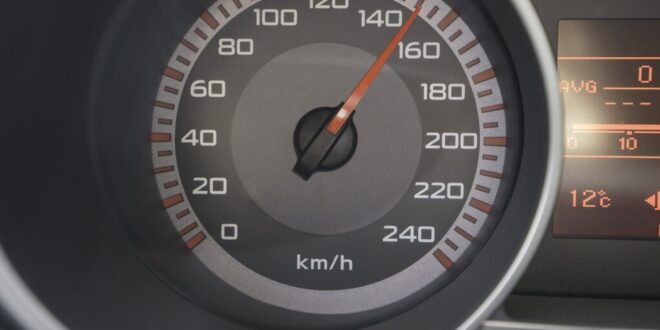A speedometer hitting 150 km/h – a speed only legal in Spain during official vehicle testing.
Credit : krigo, Shutterstock
You’ll be able to drive on Spanish roads with ease if you have spent any time there. Stick to your lane, keep your eyes peeled for cyclists and tractors, and- above all – don’t get caught speeding.
On the major motorways, it is 120 km/h. However, on smaller country roads, with more twists and turns, this limit drops to 90km/h. Everybody knows someone who was stung with a speeding penalty, and everyone complains about the mobile radars traps that pop up in places you don’t expect.
Here’s a secret you may not have known: Spain’s traffic law contains a small exception that allows a select group of drivers to legally speed down the road up to 150 km/h. We’re definitely not talking about Formula 1 or runaway political figures. We’re talking about the folks testing new vehicles—and they’ve got the paperwork to prove it.
Driving over 120 km/h in Spain is legal
Before you start to get funny ideas, it’s not a loophole that you can sneak through by giving a wink or a nod at the Guardia Civil. The top speed limit for average drivers is still firmly set. On motorways, cars, motorbikes and motorhomes weighing less than 3,500kg are allowed to travel at 120 km/h. Buses and lorries are restricted to 90 km/h, while anyone towing a vehicle is limited to 80 to 90 km/h, depending on where you live.
But every once in a while, especially near the big car manufacturing plants or on a remote stretch of autovía, you might spot something a bit unusual: a car or van streaking by, clearly breaking the speed limit, but closely followed by a convoy of official-looking vehicles. Look closely and you’ll find that the vehicles are marked up with special striped and a “V-12 sign” on the rear. That’s the magic pass—proof that this isn’t just some speed junkie out for a thrill, but an official test in progress.
Spanish speed limits: who gets special permission?
Why would Spain allow someone to travel at such a fast pace? It’s all about safety—ironically enough. To test a new car model or a major update, automakers need to know how it performs at high speeds. This means taking the vehicle to the limit, but only under strict control and after receiving the go-ahead from the authorities.
It’s not something that just happens. Car companies—or specialist testing labs—have to ask for special permission from the DGT (that’s Spain’s traffic directorate, and yes, they’re very picky). Tests can only be conducted on specific roads. They cannot take place in the middle a bustling town or near places with clearly marked lower speed limits. The vehicle should be covered with high-visibility stripes to ensure that nobody misses what is going on. And, crucially, the only people allowed to drive are those named on the permission slip—no swapping with your mate halfway down the road.
Even the rules for who is allowed to ride along are strict. The owner of the vehicle is usually allowed to ride along, as well as someone who has been “in service”, or working for the manufacturer. These aren’t wild rides for fun—they’re serious business, and one slip-up means the paperwork gets yanked.
What the speed limits in Spain mean to everyday drivers
Does this mean we get a free ride if “we’re just testing something out?” Not a chance. Most drivers still follow the old rules: 120 km/h in the motorways and 90 on main roads. If the weather is bad or you are towing a heavy object, it’s best to drive slower. The police are not very tolerant of excuses. And those automatic cameras have a reputation for being unforgiving.
But next time you see what looks like a professional rally car flying down the autovía at breakneck speed, don’t assume someone’s lost the plot. There’s a good chance it’s just the Spanish system working as it should—balancing safety, technology, and the need to keep innovation rolling.
At the end of the day, it all comes down to one simple thing: stay informed, keep within the lines, and leave the record speeds to the professionals—at least until the DGT comes knocking with a very special invitation.
 Costa News Spain Breaking News | English News in Spain.
Costa News Spain Breaking News | English News in Spain.





